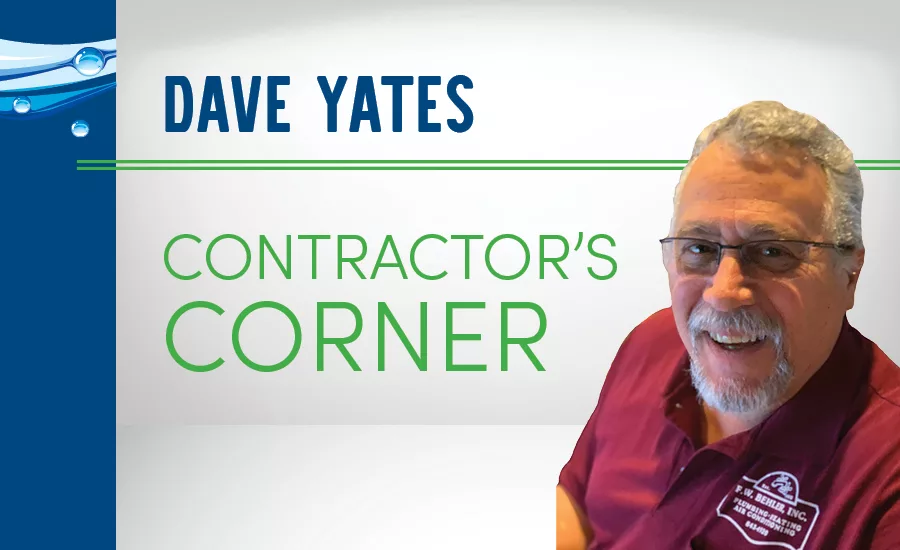Dave Yates: Troubleshooting an electric water heater
Tips and tricks of the trade.

Troubleshooting tank-style two-element electric water heaters is relatively simple once the operation is understood. When newly installed, or heavy usage outpaces storage, the tank is full of cold water. The upper element will be energized first and remain on until its thermostat is satisfied. When the upper thermostat is satisfied, it opens the circuit, providing power to the upper element, which closes the circuit to the lower element. At no time will both elements be energized simultaneously because that would cause the 30-amp breaker to trip off.
Under normal operating conditions with the tank completely heated (both thermostats satisfied), cold water passes through the dip tube and enters the base of the tank. As the cold water begins filling the tank from the bottom up, the lower thermostat engages power through its now-closed switch to the lower element. If cold water reaches the level of the upper thermostat, it closes its switch (which breaks power to the lower thermostat and element) and must be satisfied before its switch opens and provides power to the lower thermostat and its element.
As a result, the lower element works much harder than the upper element, which is why the bottom element is often the one burned out. Long, long ago, before experience taught me some hard lessons, I would just replace the lower element and call it a day. Enter the School of Hard Knocks! “That repair job only provided hot water for a few days. This had better be under warranty.” Upon returning, I would discover the upper element was now burned out, or one of the thermostats had stopped working, and I had to eat both time and materials. My new policy became: Replace both elements and thermostats at the same time. End of callbacks!
Troubleshooting checklist
Imagine you get a call for an electric water heater because the owners are running out of hot water and there is water on the floor around the water heater. A logical series of steps will determine any issues.
- First question was how long before you run out of hot water, and the answer was about 20 minutes. That ruled out the dip tube being an issue, as a cracked or broken dip tube will see lukewarm water within the first few minutes due to the cold water now traveling across the top of the tank to mix with the outgoing water from the tank.
- Turn off the power, then remove both the upper and lower access panels and the safety shields to fully expose the wiring terminals. Open the water heater’s junction box to reveal wiring connections and check the wire nuts to ensure they are securely fastened and no bare copper is exposed. Observe the thermostat temperature settings and take pictures to document both of them.
- Turn power back on, and either turn up the thermostat(s) to close the switch so they engage the element. Check power at terminals 1 and 3 to determine voltage (see this Apcom 2-element wiring link) and check the amp-draw using an amprobe. Both of the elements register 18.8-amps, and your electric meter shows 235 volts. Ohm’s Law tells us that, in spite of the element’s wattage rating, actual watts are 4,418. 3.412 watts equals 1 Btu/h, which indicates a 15,074.216 Btu/h input. It’s time to check the storage temperature, and you discover it is well above 140° F! They’re already running out of hot water, so turning the storage temperature down will only make that worse. Clearly an ASSE-listed scald-guard thermostatic mixing valve is required to protect the occupants from being scalded. We must always consider design day conditions, and they tell you they run out of hot water mostly during winter months. No matter where you live, if your customer is on a municipal water system, the coldest time during winter will see incoming cold water at 40°. If 120° is the target temperature, that requires an 80° increase in water temperature. Water weighs 8.34 pounds x 80 = 667.2 Btu per gallon. Dividing our Btu/h input by this number indicates a recovery rate of .377 gallons per minute, or 22.59 gallons per hour.
- Check all of the water heater’s openings for a leak. Finding none, you discover the inside of the temperature & pressure relief valve’s drain tube is wet, which means either the T&P valve is worn out, fouled or leaking due to thermal expansion. Checking for thermal expansion, you discover their water pressure is close to 100 psi. Plumbing codes dictate a PRV (pressure reducing valve) is required if static pressure exceeds 80 psi, so we’ll add that to the list.
Why can’t both elements be engaged for heating at the same time? The water heater’s breaker is rated at 30 amps, and per electric codes, the actual maximum load should not exceed 80% of a breaker's amperage rating. 30 x 0.8 = 24 amps. Each of our elements, in this case, are drawing 18.8 amps, which is well within the breaker’s safe load rating, but both elements on at the same time would cause the breaker to trip off.
You can easily check a water heater’s element by turning off power and removing both wires while using an ohmmeter. Place the ohmmeter’s leads onto the element’s two terminals and check for resistance. If none is detected, the element will need to be replaced. Next, check each terminal with one test lead while touching the steel tank with the other lead. The ohmmeter must show no reading or, again, the element will need to be replaced.
The upper thermostat contains a thermodisc high limit with maximum allowable water temperature between 170° to 200°. Once tripped, the safety must be manually reset by pressing on the red button — you will hear an audible click when the disc is reset. Check to ensure the tabs holding the upper thermostat are bringing the back of the thermodisc into direct contact with the tank. If you encounter a tripped thermodisc, you’ll need to stick around, or return, to check water temperature once the tank has fully reheated.
We had homeowners who indicated they were running out of hot water and that the water heater was leaking. Through a logical step-by-step process, we determined the following: A PRV was needed; an ASSE-listed TMV was required; and that a larger water heater might be needed.
Backstory on the video: Dateline NBC aired a show where they deliberately selected contractors they had determined were not, shall we say, exactly above-board. They set up an electric water heater with what would be an easy fix for a pro and then featured a parade of contractors who attempted to deceive the “customer” by stating her electric water heater had to be replaced. This video was my response regarding how pros troubleshoot an electric water heater. In it, I walk the viewer through the steps outlined above.
Video courtesy of Dave Yates.
Looking for a reprint of this article?
From high-res PDFs to custom plaques, order your copy today!









